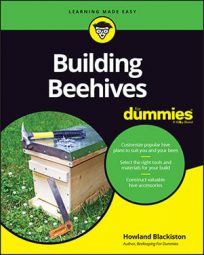The following tables break down the Warré hive into its individual components and provide instructions on how to cut and build those components. This design involves making rabbet cuts.
Lumber in a store is identified by its nominal size, which is its rough dimension before it’s trimmed and sanded to its finished size at the lumber mill. The actual finished dimensions are always slightly different from the nominal dimensions. For example, what a lumberyard calls 1 inch x 6 inch lumber is in fact 3/4 inch x 5-1/2 inch, and 2 inch x 3 inch lumber is actually 1-1/2 inch x 2-1/2 inch.
In the following tables, each Material column lists nominal dimensions, and each Dimensions column lists the actual, final measurements.
| Quantity | Material | Dimensions | Notes |
|---|---|---|---|
| 4 | 2" x 3" knotty pine | 37/8" x 2-1/2" x 1-1/2" | These are the leg posts that elevate the hive off the ground. |
| 1 | 3/8" exterior plywood | 16-1/8" x 65/16" x 3/8" | This is the bees’ landing board. |
| 1 | 3/8" exterior plywood | 13-1/4" x 13-1/4" x 3/8" | This is the floor. Cut a 4-11/16" x 4-13/16" notch centered along one edge of the floor board. This is the entrance to the hive. |
![[Credit: Illustration by Felix Freudzon, Freudzon Design]](https://www.dummies.com/wp-content/uploads/356620.image0.jpg)
Credit: Illustration by Felix Freudzon, Freudzon Design
| Quantity | Material | Dimensions | Notes |
|---|---|---|---|
| 8 | 1" x 10" knotty pine | 13-5/16" x 8-1/4" x ¾" | These are the long sides. |
| 8 | 1" x 10" knotty pine | 11-13/16" x 8-1/4" x 3/4" | These are the short sides. Rabbet a cut 5/8" wide by 3/8" deep along one entire inside top edge. This is the ledge on which the top bar frames sit (frame rest). |
| 8 | Use the leftover lumber from your 1" x 10" knotty pine | 10" x 2" x 3/4" | These are the hand rails. Each hive box has two (you make four hive boxes total, hence eight rails). |
![[Credit: Illustration by Felix Freudzon, Freudzon Design]](https://www.dummies.com/wp-content/uploads/356621.image1.jpg)
Credit: Illustration by Felix Freudzon, Freudzon Design
![[Credit: Illustration by Felix Freudzon, Freudzon Design]](https://www.dummies.com/wp-content/uploads/356622.image2.jpg)
Credit: Illustration by Felix Freudzon, Freudzon Design
| Quantity | Material | Dimensions | Notes |
|---|---|---|---|
| 32 | 1" x 10" knotty pine | 12-3/8" x 1" x 3/4" | Rabbet a cut 7/16" deep by 5/8" long at each end of the top bars. Cut a saw kerf on the bottom side centered along the entire length, 1/8" wide by 1/4" deep (you’ll place a starter strip of wood into this groove). |
| 32 | 3/32" balsa wood | 10" x ¾" x 3/32" | These are the starter strips that you glue into the kerf cut groove. |
![[Credit: Illustration by Felix Freudzon, Freudzon Design]](https://www.dummies.com/wp-content/uploads/356623.image3.jpg)
Credit: Illustration by Felix Freudzon, Freudzon Design
| Quantity | Material | Dimensions | Notes |
|---|---|---|---|
| 2 | 1" x 10" knotty pine | 13-5/16" x 3-15/16" x ¾" | These are the long sides. |
| 2 | 1" x 10" knotty pine | 11-13/16" x 3-15/16" x ¾" | These are the short sides. |
![[Credit: Illustration by Felix Freudzon, Freudzon Design]](https://www.dummies.com/wp-content/uploads/356624.image4.jpg)
Credit: Illustration by Felix Freudzon, Freudzon Design
| Quantity | Material | Dimensions | Notes |
|---|---|---|---|
| 2 | 1" x 10" knotty pine | 19-3/4" x 8-5/16" x 3/4" | These are the inclined roof boards. |
| 2 | 1" x 10" knotty pine | 15-3/8" x 8-5/16" x 3/4" | These are the roof gables. Along the designated top edge of each gable, make a mark with a pencil 6-7/8" in from the outside edges. Measuring from the top edge, make a pencil mark 2" down on each side edge. Make an angled cut from marks on the top edge to the marks on the side edge. Do this on both sides of each roof gable. This creates the correct pitch for the gables. It’s helpful to refer to the following figure. |
| 2 | 1" x 10" knotty pine | 13-7/8" x 4-3/4" x ¾" | These are the short sides. |
| 1 | 1" x 10" knotty pine | 19-3/4" x 3" x ¾" | This is the roof ridge board. |
| 1 | 3/8" exterior plywood | 15-3/8" x 13-7/8" x 3/8" | This is the inner cover board. |
![[Credit: Illustration by Felix Freudzon, Freudzon Design]](https://www.dummies.com/wp-content/uploads/356625.image5.jpg)
Credit: Illustration by Felix Freudzon, Freudzon Design
![[Credit: Illustration by Felix Freudzon, Freudzon Design]](https://www.dummies.com/wp-content/uploads/356626.image6.jpg)
Credit: Illustration by Felix Freudzon, Freudzon Design

